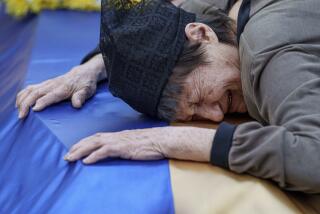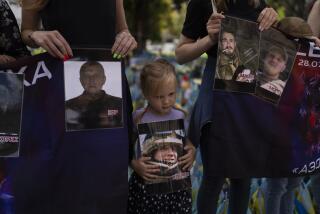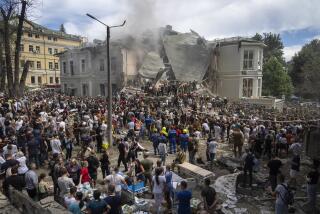Searching for Answers in a Tragedy
- Share via
TERZINSKI MOST, Yugoslavia — NATO’s acknowledgment that one of its pilots had accidentally bombed a column of Kosovo Albanian refugees doesn’t begin to explain how scores of people were killed in what survivors say was a series of airstrikes.
A Times journalist who visited three sites that were attacked along a 12-mile stretch of highway in southwestern Kosovo counted at least 14 dead--some incinerated or decapitated by Wednesday’s bomb blasts.
At least eight other ethnic Albanian refugees died the same day, about 90 minutes earlier, at a fourth site about eight miles to the west of here. That attack was on a dirt road in Meja village, west of Djakovica. Terzinski Most is east of Djakovica. The first airstrikes, west of Djakovica, left similar craters, bomb fragments and carnage as the more intense series of attacks later the same afternoon on the main road heading east from Djakovica.
The total death toll is up to 82 Kosovo Albanian refugees, with at least as many wounded, according to Dr. Kiril Cvetinov, a Yugoslav army colonel and surgeon who operated on many of the victims at a nearby hospital.
The Kosovo Albanian survivors tell of jets divebombing, circling and then bombing again as tractors and horses pulling wagonloads of terrified refugees tried to escape.
At the time of the attacks east of Djakovica, a reporter several miles away could hear a steady roar of jet noise and explosions as NATO warplanes attacked targets near the Albanian border.
With such concentrated NATO air traffic, it’s difficult to see how a Yugoslav jet could sneak in and attack the refugee column just for Belgrade’s propaganda purposes.
The shrapnel spray patterns, small craters and distinct pieces left behind are almost identical at all of the bombed sites, lending support to refugees’ accounts that they were bombed several times by the same NATO planes.
The journalist’s trips to Meja on Wednesday afternoon, and then the bombed sites east of Djakovica on Thursday morning, were neither escorted nor controlled by government officials.
Agim Silaj, 32, was driving the third tractor in a convoy transporting about 5,000 refugees when the convoy came under attack at Terzinski Most, a short bridge about five miles east of Djakovica on the road to Prizren, on Wednesday, sometime around 3 p.m.
The Kosovo Albanians in Silaj’s group were fleeing from Dobrash, a village about six miles northwest of Djakovica, next to Kosovo’s border with Albania.
The region is on the front lines in a war between Yugoslav forces and what they say are Kosovo Liberation Army guerrillas trying to infiltrate Kosovo from Albania.
Silaj said he and the other refugees were heading for Prizren, where they hoped to go on and cross into Albania, as tens of thousands had before them in the past three weeks.
Many say they were forced from their homes at gunpoint by Serbian security forces, while others say they were trying to escape an escalating war on the ground and in the air.
None of the survivors interviewed confirmed NATO’s claim that military vehicles were trying to hide in their long convoy. NATO said it aimed at military targets only.
Silaj said he heard jets coming in low, and then he counted four explosions. He said there was a long enough gap between the first two explosions for him to drive about 300 yards in an old farm tractor pulling about 25 people.
“We heard an explosion once and we didn’t know what it was, so then we started moving again,” Silaj said Thursday at a makeshift camp beside the road where he was hit, about five miles east of Djakovica.
“The second time we were hit, the tractor in front exploded. We didn’t know what was going on,” he repeated, “so we continued. We were hit several times.”
After the fourth blast, Silaj said, he and his passengers finally ran for cover in a row of metal barns near the roadside. From there, they saw a wagonload of people and its driver go up in flames.
Silaj insisted that he heard several jets, streaking so low that he could see a bomber for the first time since NATO’s air war against Yugoslavia began March 24. The aircraft that Silaj saw was a grayish color, he said.
“They were coming very low and dived down, and then went up again,” he said, demonstrating a divebombing attack with his hand.
About 50 yards from where Silaj reenacted the horror, the bodies of six ethnic Albanians were laid out on blankets, waiting to be transported to the morgue.
Two of them were girls, another a woman old enough to be their mother. Beside her was an elderly woman. Next to her was a man--the whole top of his head had been blown off.
Thirty yards away from those bodies, in the grass, a man’s head lay several paces away from an arm. Just up the embankment, the burnt remains of a tractor and wagon rested at a 45-degree angle to a second one.
The tractors stood on the right side of the road. A bomb, or rocket, had exploded just a few yards away, where the left side of the road met the dirt shoulder.
The crater, like almost all of those seen at four attack sites both east and west of Djakovica, was about 3 yards long and 3 yards wide.
The explosion had set the closest tractor on fire, and the charred corpses of at least four people lay in the wagon Thursday. Another body was still at the driver’s seat, while a sixth was on the road under the wagon.
Just over two miles farther up the two-lane highway to Prizren, the ruins of two more tractors with refugee wagons stood about 100 yards apart on the right side of the road.
Suitcases were tossed everywhere, and the contents spilled out all over the road. Among the new toothbrushes, a pocket photo album and some diapers, was a government booklet recording the health checkups of Ramaj Jetan, aged 4.
A direct hit blew the first tractor to pieces. On the roadside, an elderly man’s corpse sat leaning against a leafless tree. Both of his legs were blown off.
In the other lane of traffic, a white Mercedes-Benz had been destroyed while going in the opposite direction. Bombs had blasted two craters several yards apart on that side of the road too.
The craters were similar in size and shape to the others seen along the highway and the dirt road through Meja, where survivors said they were attacked between 1 p.m. and 1:45 p.m. Wednesday.
The estimated times in the refugees’ accounts vary slightly, in part because they were in shock or were too busy trying to escape to check the time.
But the first airstrike at Meja came at least 90 minutes before the Mercedes and the tractors were hit several miles away.
Yet the same metal part shaped like a single propeller blade, or stabilizer, and metal coils were found in the craters at both sites.
Ismet Sulja, 46, was driving the lead tractor in a column that was first attacked at Zrze, at a third site just under two miles past the destroyed Mercedes, in the direction of Prizren.
“There were no victims when they hit us there, so we continued moving as fast as we could,” Sulja said at Prizren’s hospital, where his son Skumbin, 19, and nephew Ardian, 10, lay wounded.
“When we reached Perane [about five miles farther east], they hit us a couple of times,” Sulja added.
Once the explosions had stopped, and Sulja could turn to count the dead and wounded amid the screams and crying, he realized just how hard those hits had come from the sky.
“I had 25 people in my tractor,” Sulja said. “Eleven were wounded and three were dead.”
All of Paul Watson’s dispatches from Kosovo are available on The Times’ Web site at http://shop.nohib.com./dispatch.
Many charities are accepting contributions to help refugees from Kosovo. The list may be found at http://shop.nohib.com./kosovoaid.
More to Read
Sign up for Essential California
The most important California stories and recommendations in your inbox every morning.
You may occasionally receive promotional content from the Los Angeles Times.










